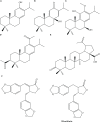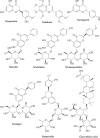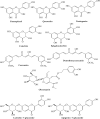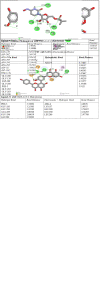In silico investigation and potential therapeutic approaches of natural products for COVID-19: Computer-aided drug design perspective
- PMID: 36072227
- PMCID: PMC9441699
- DOI: 10.3389/fcimb.2022.929430
In silico investigation and potential therapeutic approaches of natural products for COVID-19: Computer-aided drug design perspective
Abstract
The severe acute respiratory syndrome coronavirus 2 (SARS-CoV-2) has caused a substantial number of deaths around the world, making it a serious and pressing public health hazard. Phytochemicals could thus provide a rich source of potent and safer anti-SARS-CoV-2 drugs. The absence of approved treatments or vaccinations continues to be an issue, forcing the creation of new medicines. Computer-aided drug design has helped to speed up the drug research and development process by decreasing costs and time. Natural compounds like terpenoids, alkaloids, polyphenols, and flavonoid derivatives have a perfect impact against viral replication and facilitate future studies in novel drug discovery. This would be more effective if collaboration took place between governments, researchers, clinicians, and traditional medicine practitioners' safe and effective therapeutic research. Through a computational approach, this study aims to contribute to the development of effective treatment methods by examining the mechanisms relating to the binding and subsequent inhibition of SARS-CoV-2 ribonucleic acid (RNA)-dependent RNA polymerase (RdRp). The in silico method has also been employed to determine the most effective drug among the mentioned compound and their aquatic, nonaquatic, and pharmacokinetics' data have been analyzed. The highest binding energy has been reported -11.4 kcal/mol against SARS-CoV-2 main protease (7MBG) in L05. Besides, all the ligands are non-carcinogenic, excluding L04, and have good water solubility and no AMES toxicity. The discovery of preclinical drug candidate molecules and the structural elucidation of pharmacological therapeutic targets have expedited both structure-based and ligand-based drug design. This review article will assist physicians and researchers in realizing the enormous potential of computer-aided drug design in the design and discovery of therapeutic molecules, and hence in the treatment of deadly diseases.
Keywords: COVID-19; SARS-CoV-2; alkaloids; drug design; natural products; virtual screening.
Copyright © 2022 Rahman, Islam, Akash, Mim, Rahaman, Emran, Akkol, Sharma, Alhumaydhi, Sweilam, Hossain, Ray, Sultana, Ahmed, Sobarzo-Sánchez and Wilairatana.
Conflict of interest statement
The authors declare that the research was conducted in the absence of any commercial or financial relationships that could be construed as a potential conflict of interest.
Figures






Similar articles
-
A Computer-Aided Drug Design Approach to Predict Marine Drug-Like Leads for SARS-CoV-2 Main Protease Inhibition.Mar Drugs. 2020 Dec 10;18(12):633. doi: 10.3390/md18120633. Mar Drugs. 2020. PMID: 33322052 Free PMC article.
-
Development of Effective Therapeutic Molecule from Natural Sources against Coronavirus Protease.Int J Mol Sci. 2021 Aug 30;22(17):9431. doi: 10.3390/ijms22179431. Int J Mol Sci. 2021. PMID: 34502340 Free PMC article.
-
An Updated Review of Computer-Aided Drug Design and Its Application to COVID-19.Biomed Res Int. 2021 Jun 24;2021:8853056. doi: 10.1155/2021/8853056. eCollection 2021. Biomed Res Int. 2021. PMID: 34258282 Free PMC article. Review.
-
In Silico Screening of Some Active Phytochemicals to Identify Promising Inhibitors Against SARS-CoV-2 Targets.Curr Drug Discov Technol. 2024;21(3):73-89. doi: 10.2174/0115701638243222230920051050. Curr Drug Discov Technol. 2024. PMID: 37861016
-
Molecular scaffolds from mother nature as possible lead compounds in drug design and discovery against coronaviruses: A landscape analysis of published literature and molecular docking studies.Microb Pathog. 2021 Aug;157:104933. doi: 10.1016/j.micpath.2021.104933. Epub 2021 May 11. Microb Pathog. 2021. PMID: 33984466 Free PMC article. Review.
Cited by
-
In Silico Discovery of Small-Molecule Inhibitors Targeting SARS-CoV-2 Main Protease.Molecules. 2023 Jul 10;28(14):5320. doi: 10.3390/molecules28145320. Molecules. 2023. PMID: 37513194 Free PMC article.
-
Safety Study and Compositional Analysis of the Svarnvir-IV Tablet With Special Reference to Its Therapeutic Utility in SARS-CoV-2.Cureus. 2024 Dec 10;16(12):e75438. doi: 10.7759/cureus.75438. eCollection 2024 Dec. Cureus. 2024. PMID: 39791040 Free PMC article.
-
Interference of small compounds and Mg2+ with dsRNA-binding fluorophores compromises the identification of SARS-CoV-2 RdRp inhibitors.Sci Rep. 2024 Nov 15;14(1):28250. doi: 10.1038/s41598-024-78354-x. Sci Rep. 2024. PMID: 39548173 Free PMC article.
-
Modified coptisine derivatives as an inhibitor against pathogenic Rhizomucor miehei, Mycolicibacterium smegmatis (Black Fungus), Monkeypox, and Marburg virus by molecular docking and molecular dynamics simulation-based drug design approach.Front Pharmacol. 2023 Apr 19;14:1140494. doi: 10.3389/fphar.2023.1140494. eCollection 2023. Front Pharmacol. 2023. PMID: 37153804 Free PMC article.
-
Integrating Computational Methods in Network Pharmacology and In Silico Screening to Uncover Multi-targeting Phytochemicals against Aberrant Protein Glycosylation in Lung Cancer.ACS Omega. 2023 May 30;8(23):20303-20312. doi: 10.1021/acsomega.2c07542. eCollection 2023 Jun 13. ACS Omega. 2023. PMID: 37332828 Free PMC article.
References
-
- Abdulrhman M., Shatla R., Mohamed S. (2016). The effects of honey supplementation on Egyptian children with hepatitis a: a randomized double blinded placebo-controlled pilot study. J. Apither 1, 23. doi: 10.5455/ja.20160702011113 - DOI
Publication types
MeSH terms
Substances
LinkOut - more resources
Full Text Sources
Research Materials
Miscellaneous

